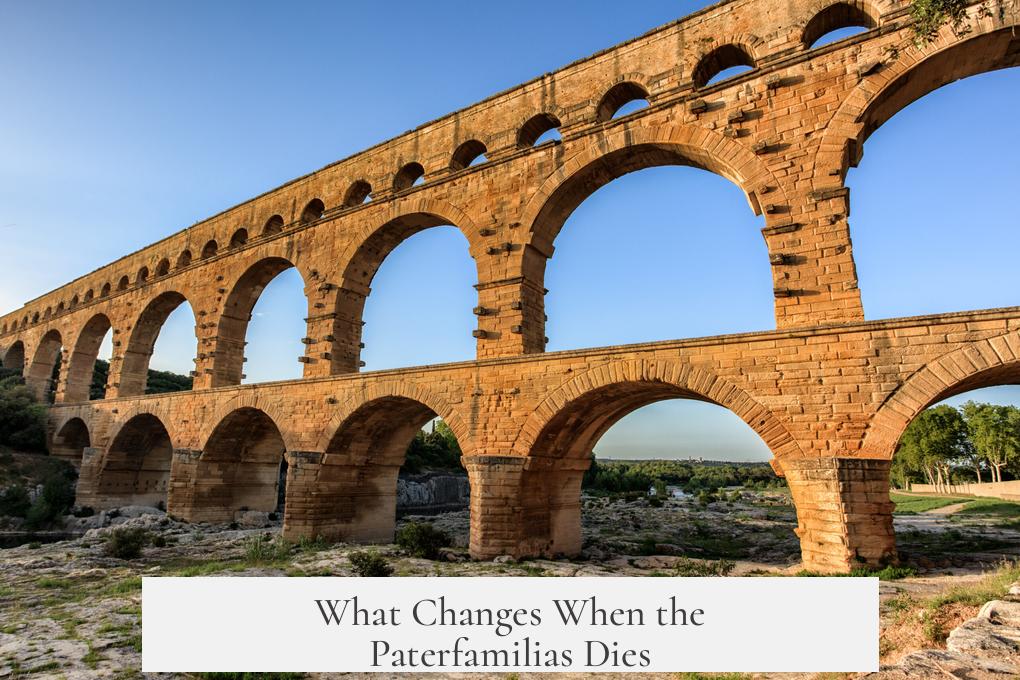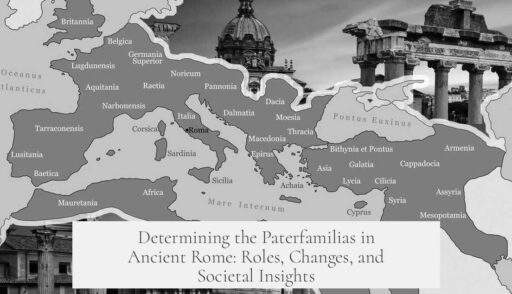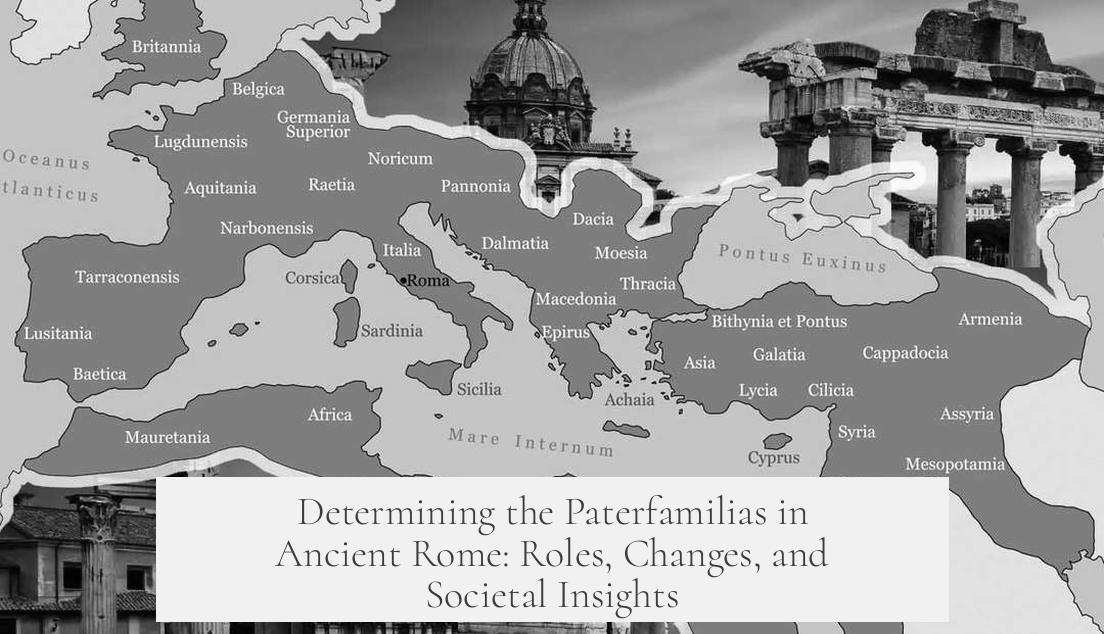A paterfamilias in ancient Rome was determined by the absence of living paternal ancestors. A man became paterfamilias when his father and paternal grandfather had died, granting him full legal authority over his family. Thus, one could not simultaneously have a paterfamilias above them and be a paterfamilias themselves, except through specific legal emancipation.
The paterfamilias was the family head who held patria potestas, the legal power over his descendants and their descendants. This role bestowed the status of sui iuris, meaning “under his own law,” giving him extensive control. Men whose fathers or grandfathers were alive were alieni iuris, legally subordinate to their paterfamilias. They might manage their children practically but lacked formal authority.
Marriage affected this structure through manus, a wife’s legal subordination to her husband’s paterfamilias under certain types of marriage. However, manus was uncommon, and most wives remained under their own fathers’ authority.
Legally, sui iuris men had exclusive control. For example, if the father is the paterfamilias, he possesses power over his children, grandchildren, and their property. He also holds ownership of family assets, though he might grant limited use rights called peculium to children or grandchildren.
Upon the paterfamilias’s death, his sons become sui iuris and acquire full patria potestas, becoming patresfamilias of their households. They no longer have authority over one another, marking the division of the family into separate legal units.
- A paterfamilias is the eldest male with no living paternal ancestors.
- One cannot be under a paterfamilias and be a paterfamilias simultaneously unless emancipated.
- Patria potestas grants control over descendants and property.
- Marriage sometimes placed wives under husband’s paterfamilias via manus.
- Death of a paterfamilias results in sons becoming independent patresfamilias.
How Was the Paterfamilias Determined in Ancient Rome? Could Someone Both Have a Paterfamilias and Be a Paterfamilias?

Imagine you’re in Ancient Rome, walking the cobblestoned streets. You might wonder: who calls the shots in a Roman family? The answer is the paterfamilias. But what exactly determined this role? And could a man both have a paterfamilias above him and be one himself? Let’s unravel this unique Roman family puzzle.
The Paterfamilias: Who Are They?
Simply put, the paterfamilias is the head of a Roman family. He is a Roman man who has no living male ancestors on his paternal line—think of it as the “top dog” in the family tree. If his father or grandfather is still alive, then that man typically fills the role of paterfamilias, not him.
This means a paterfamilias is usually the senior living male in his family lineage. He is the legal owner of all family property and wields power over all descendants under his roof. This power is known as patria potestas—fatherly authority with legal muscle.
How Is a Man Determined to Be a Paterfamilias?
- A man becomes paterfamilias when he is sui iuris—meaning he is under his own legal authority, not anyone else’s.
- This only happens if his father and paternal grandfather have passed away, removing any living male ancestor who holds power over him.
- Once established, the paterfamilias gains full potestas over his children, grandchildren, and their descendants.
- In some cases, depending on the type of marriage used, he may also hold power over his wife (manus), though this was less common.
So, to recap in simple terms: your father or grandfather’s death hands you the baton of family authority.
Can You Both Have and Be a Paterfamilias?
No, you cannot. Here is the catch that keeps Roman family order tidy: a man either has a paterfamilias above him or is the paterfamilias himself—but he cannot wear both hats at the same time. If your father is alive, he is the paterfamilias. You, even if married with kids, remain legally under his control. Your status is alieni iuris, meaning “under another’s law,” and you have no formal authority over your own children in the eyes of Roman law.
“Your father is the paterfamilias. He holds legal power over you, your children, your siblings, and even your siblings’ children.”
Anyone found in this position is practically a “dependent adult” within the legal framework—a strong version of “mum’s the word,” but for family governance.
What Changes When the Paterfamilias Dies?

At the death of the paterfamilias, a domino effect happens:
- His sons become sui iuris, freeing themselves from paternal control.
- Each son steps up as the paterfamilias of his own household, exercising his own patria potestas.
- They own their property independently. Although, they had limited proprietary interest passed on earlier, called peculium, this was usually small; the substantive family assets remained under the paterfamilias.
- No authority exists between brothers; they are equals after their father’s departure.
Try to picture this with a modern twist. It’s like the moment you officially inherit the family business after dad retires, but you can’t claim ownership while he’s still the CEO!
Unique Nuance: Emancipation and Legal Fiction
There is a rare exception to this rule: legal emancipation. If a man managed to get formally emancipated by certain legal devices, he could become sui iuris even if his father was alive. That would allow him to be a paterfamilias in practice, holding power over his own family, while technically having a living paterfamilias above him.
This wasn’t common. Usually, emancipation was used for practical reasons—maybe to allow a son to control his own wealth or family without waiting for his father to pass.
What Does This Tell Us About Roman Society?
The Roman family structure was highly hierarchical and clear-cut. It demanded respect for authority and ensured property and power stayed consolidated. Having one undisputed paterfamilias prevented legal chaos within the family. It also meant power could only be transferred through natural life progression or official emancipation.
This structure kept Roman families stable, but also created strictures on personal freedom within the family. Sons had to wait patiently to “graduate” into power, like waiting in a long queue for a turn at the throne.
Wrap-Up: The Roman Family Power Game
So, who was the paterfamilias in Ancient Rome? The paterfamilias is the eldest living male ancestor, holding full legal authority over family members. You either have a paterfamilias above you or are one yourself. No double-dipping allowed unless legal emancipation steps in.
Understanding this helps us grasp how power, property, and family roles were tightly controlled in Ancient Rome. It’s like a family board game with strict rules—but with real-life consequences!
Curious how this compares with modern families? Today, legal autonomy is individual, but the paterfamilias gives us a peek into a world where family law sticks closer than glue.
How was the paterfamilias determined in ancient Rome?
A paterfamilias was a Roman man with no living paternal ancestors, such as his father or grandfather. He was legally independent, or *sui iuris*. This status allowed him to exercise power, called *patria potestas*, over his direct descendants.
Could a man have a paterfamilias and also be a paterfamilias?
Usually not. A man with a living father or grandfather was under their authority, or *alieni iuris*. He could not legally be a paterfamilias unless formally emancipated. So, one generally either had a paterfamilias or was one, but not both simultaneously.
What happened to a man’s status when his paterfamilias died?
When a paterfamilias died, his sons became *sui iuris*. They gained independent legal authority and became patres familias themselves. They held *patria potestas* over their own families, but not over each other.
Did marriage affect a man’s status as paterfamilias?
Marriage could grant a man power over his wife, called *manus*. However, this was not common in typical marriages. So, being a paterfamilias didn’t always mean control over a wife.
Could younger men exercise real control over their children before becoming paterfamilias?
Practically, yes. A man under his father’s authority might manage his children in daily life. Legally, though, the true power remained with the living paterfamilias above him.



